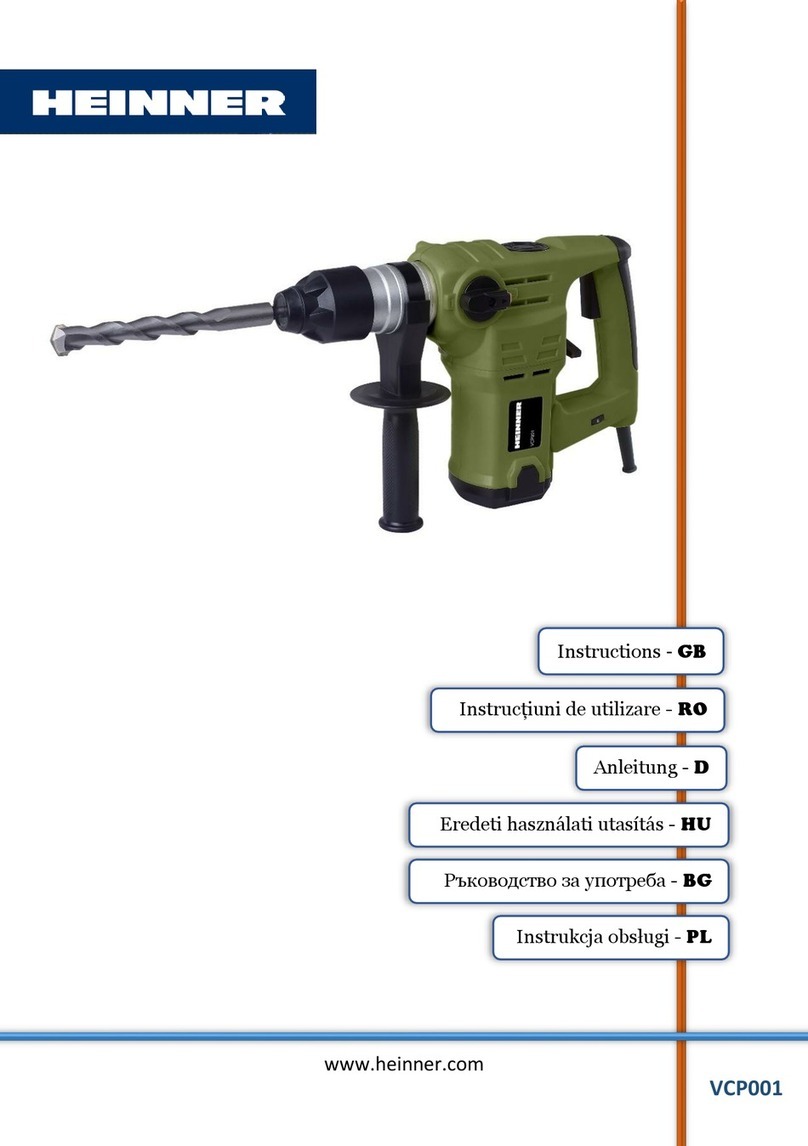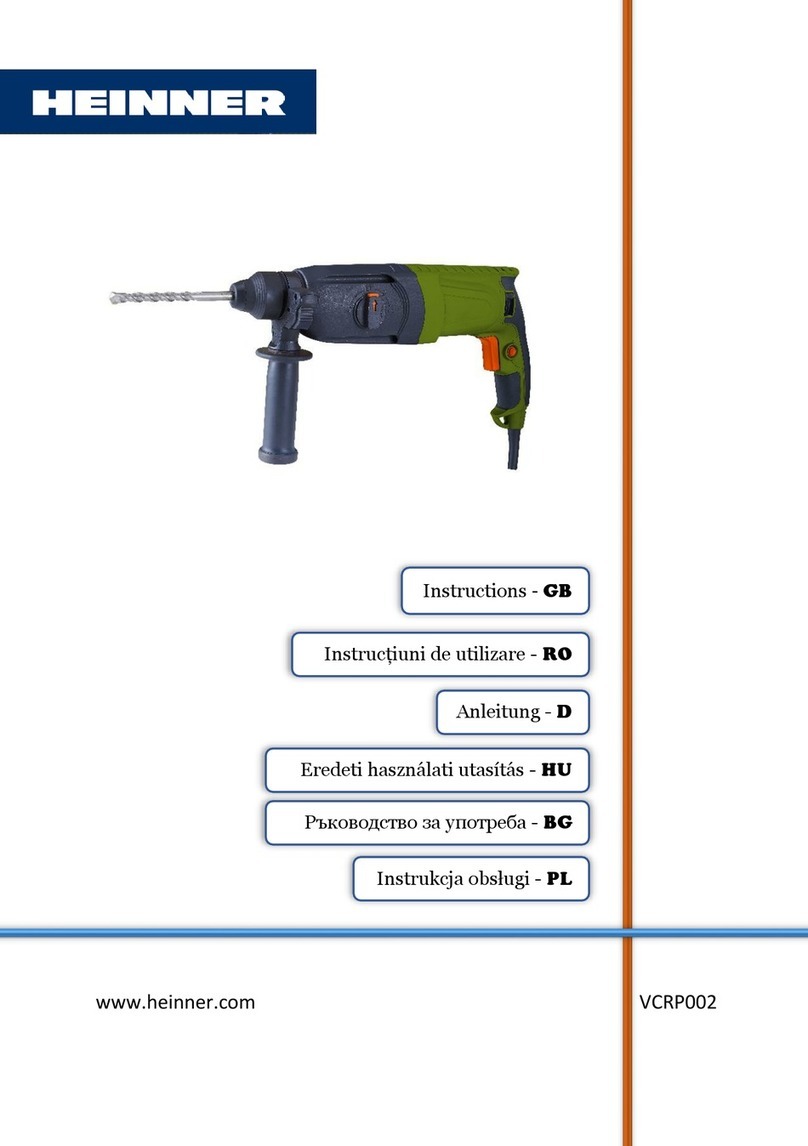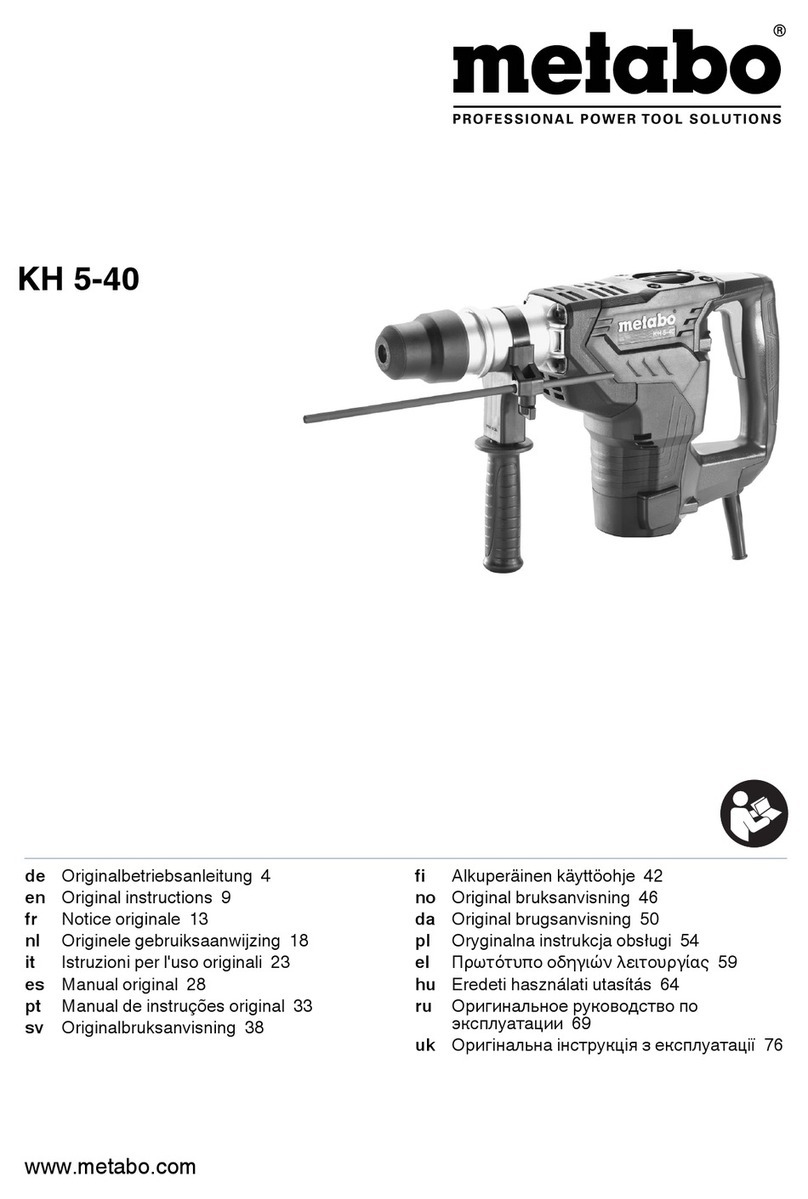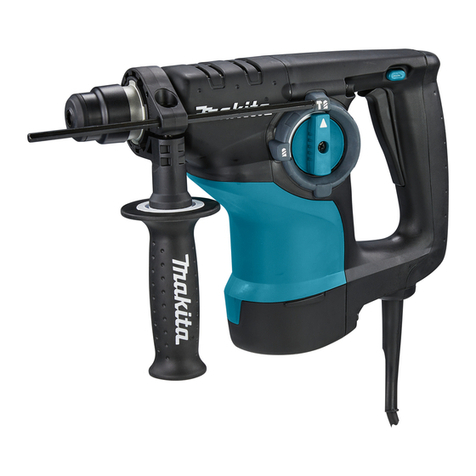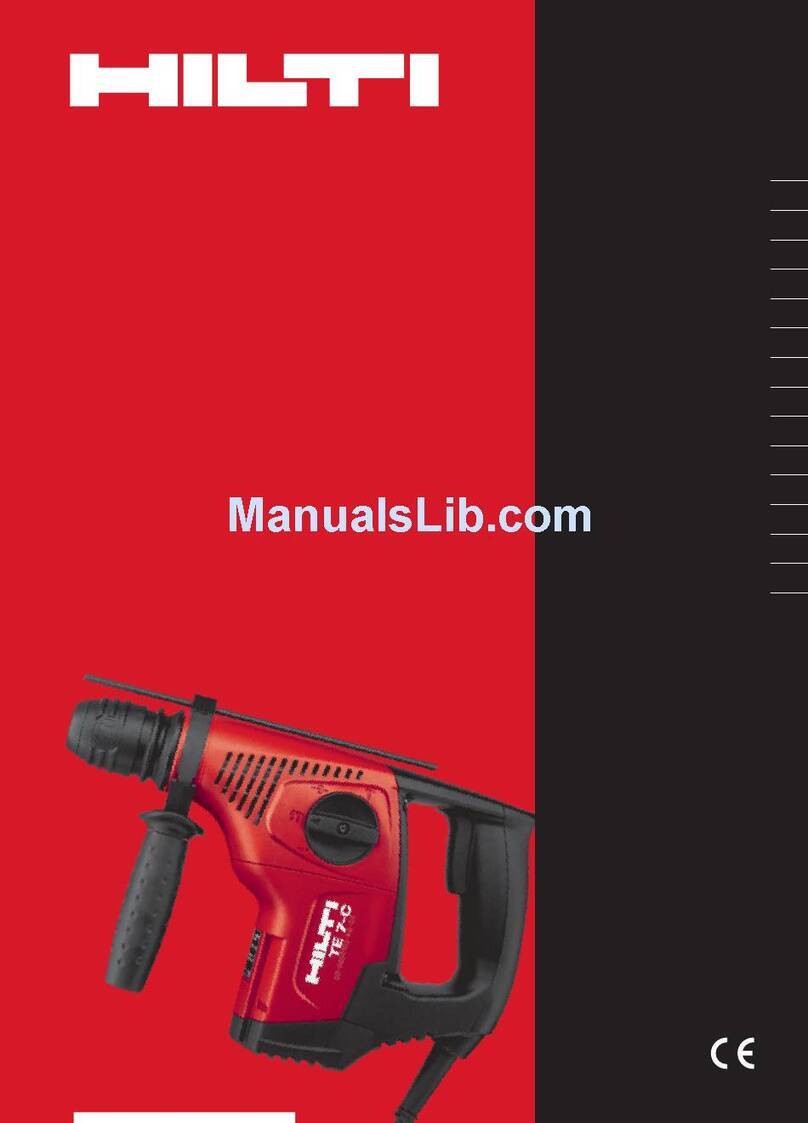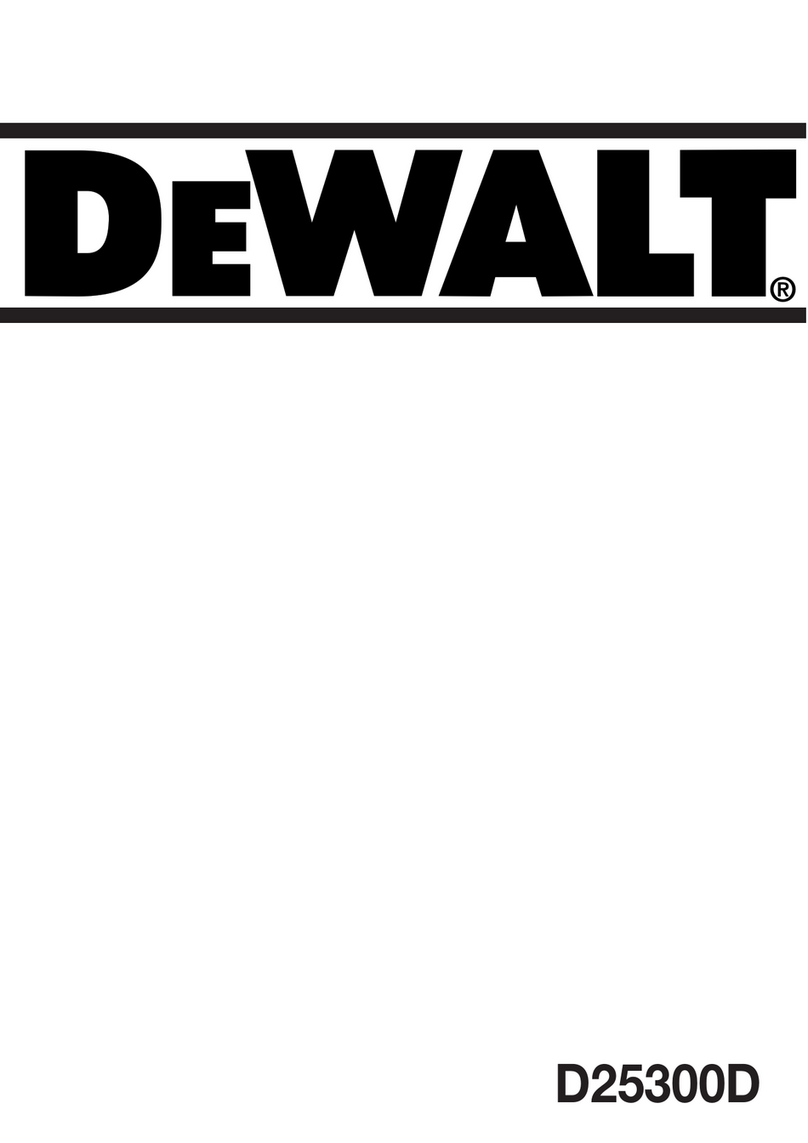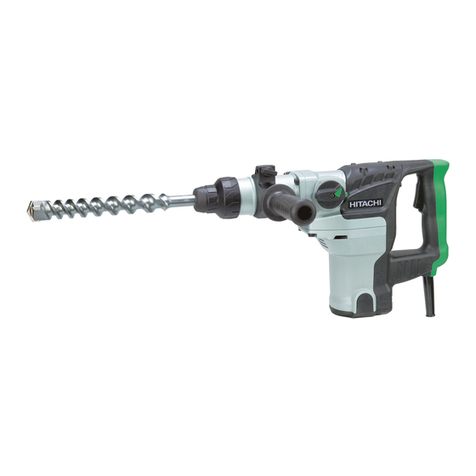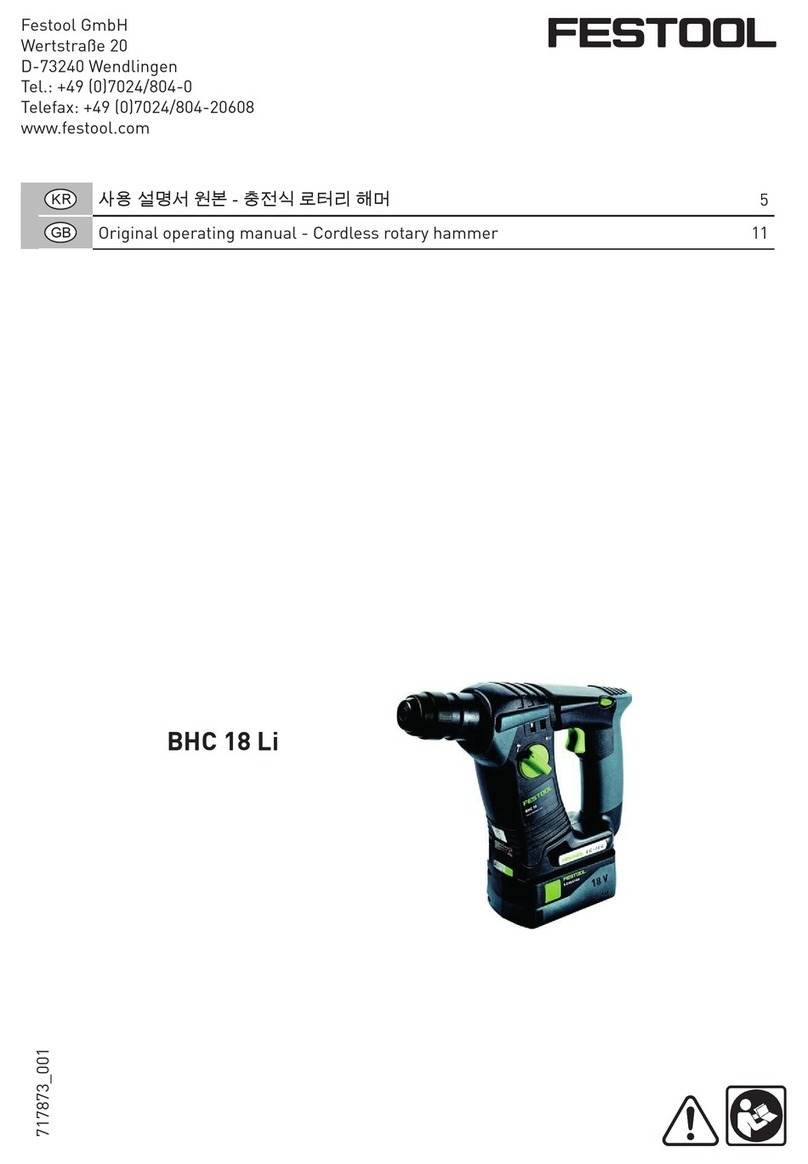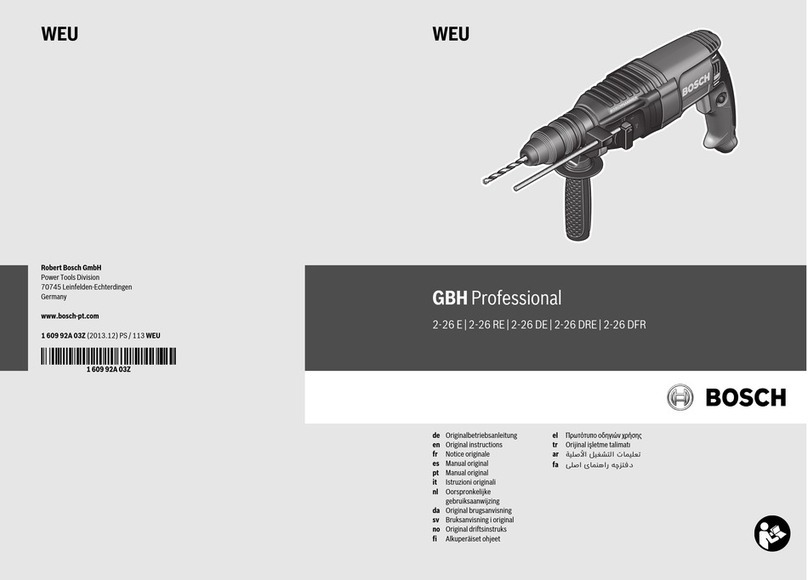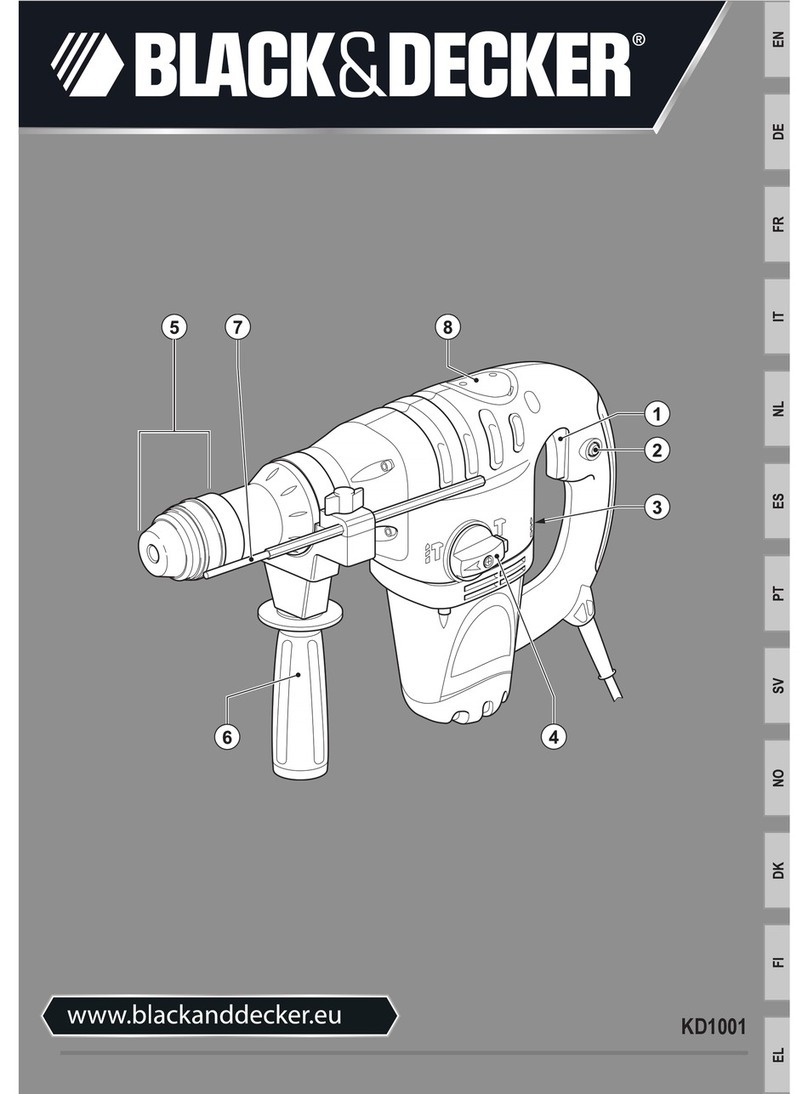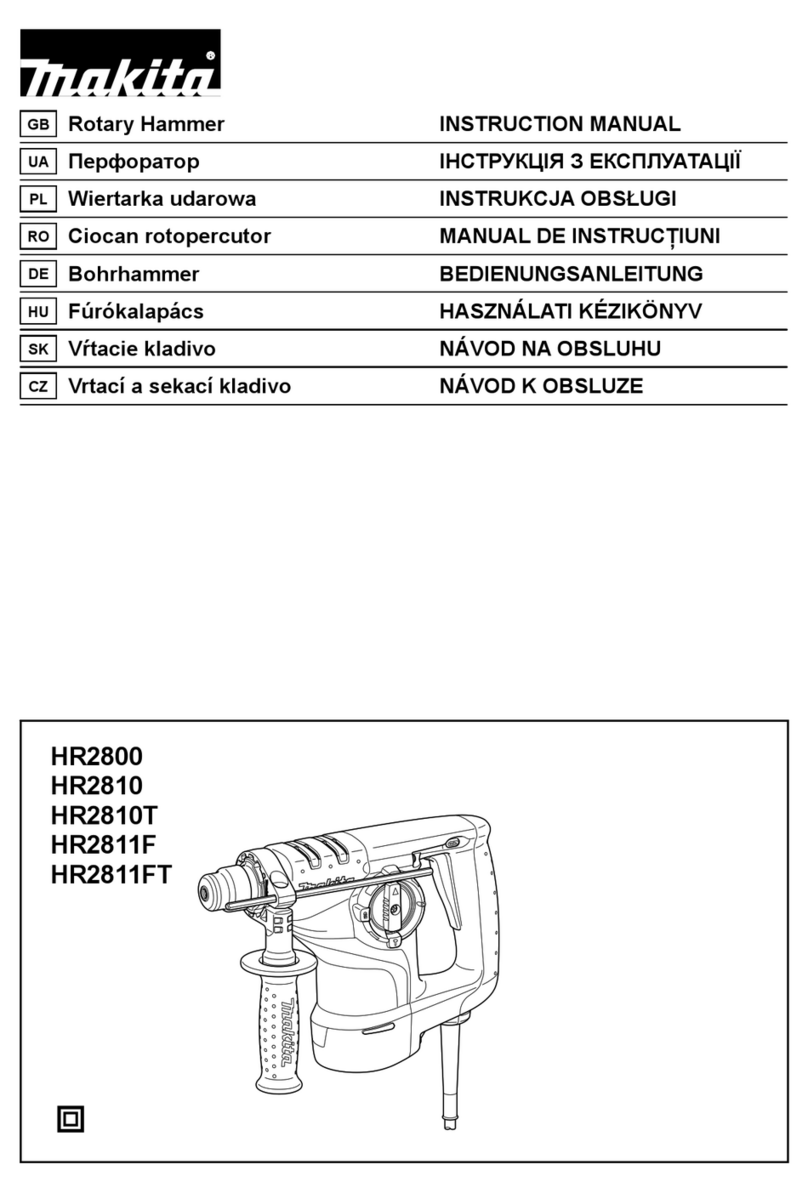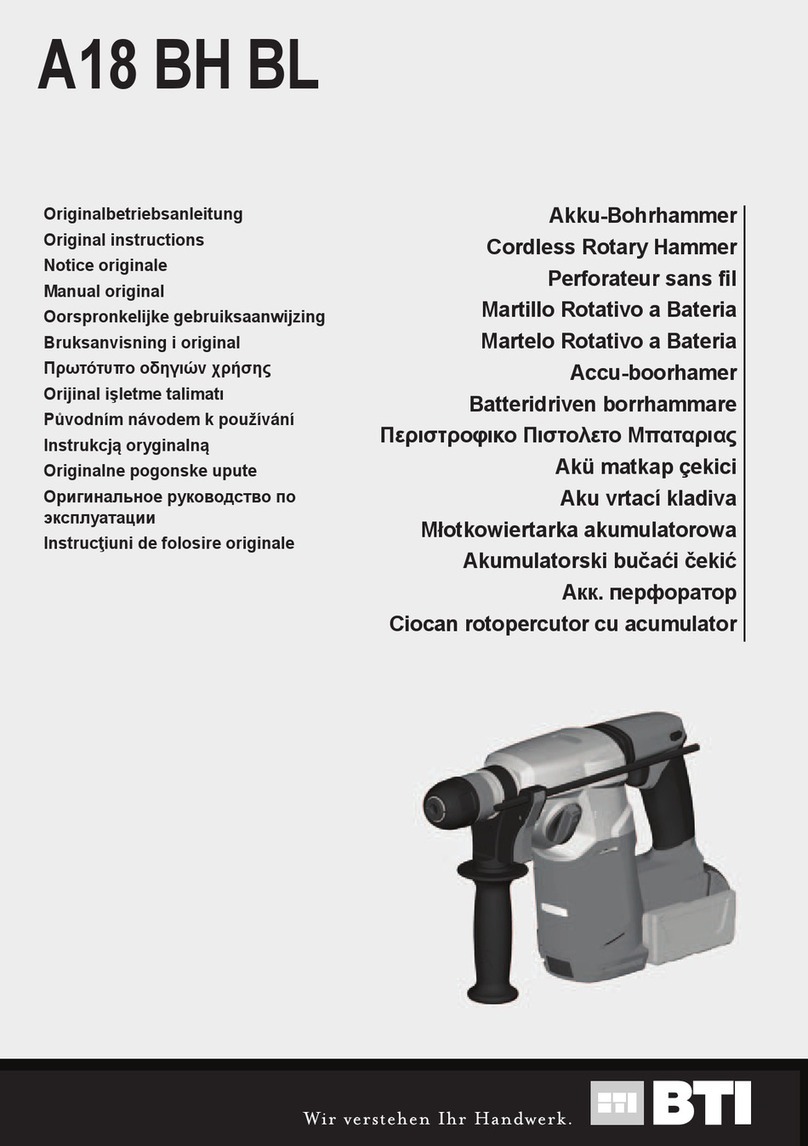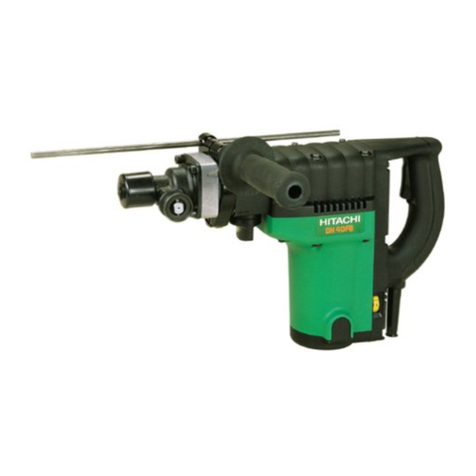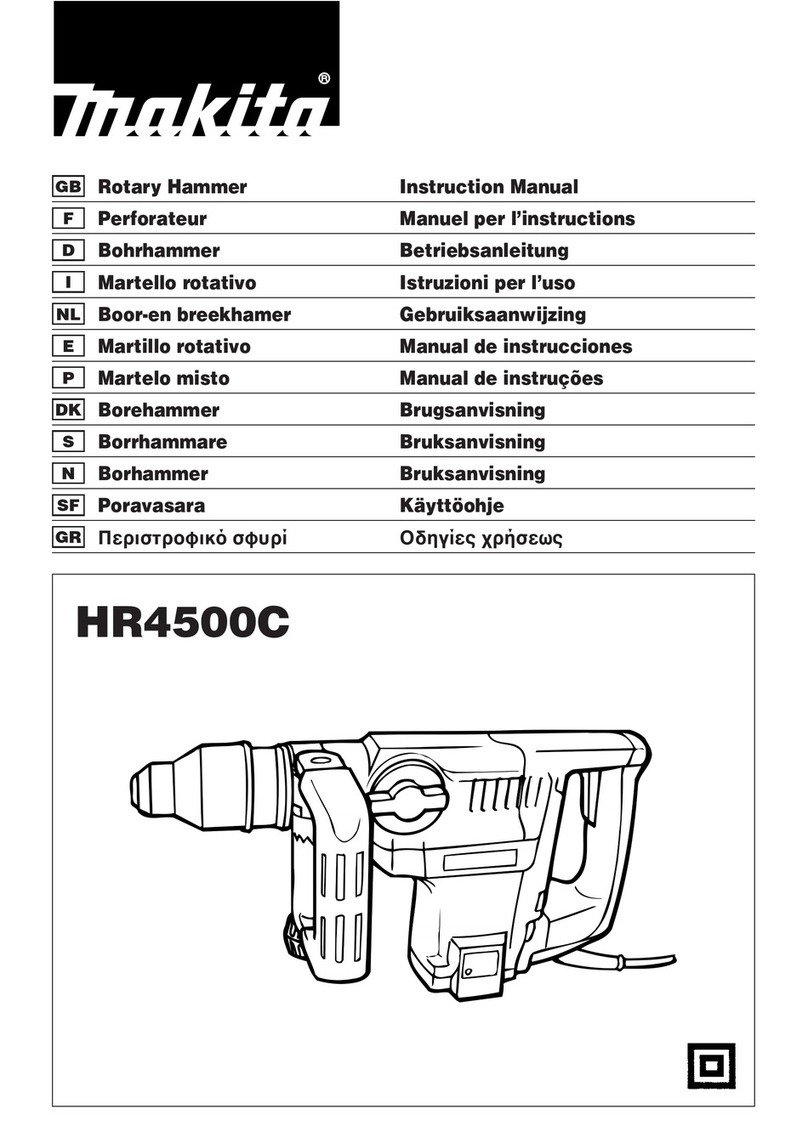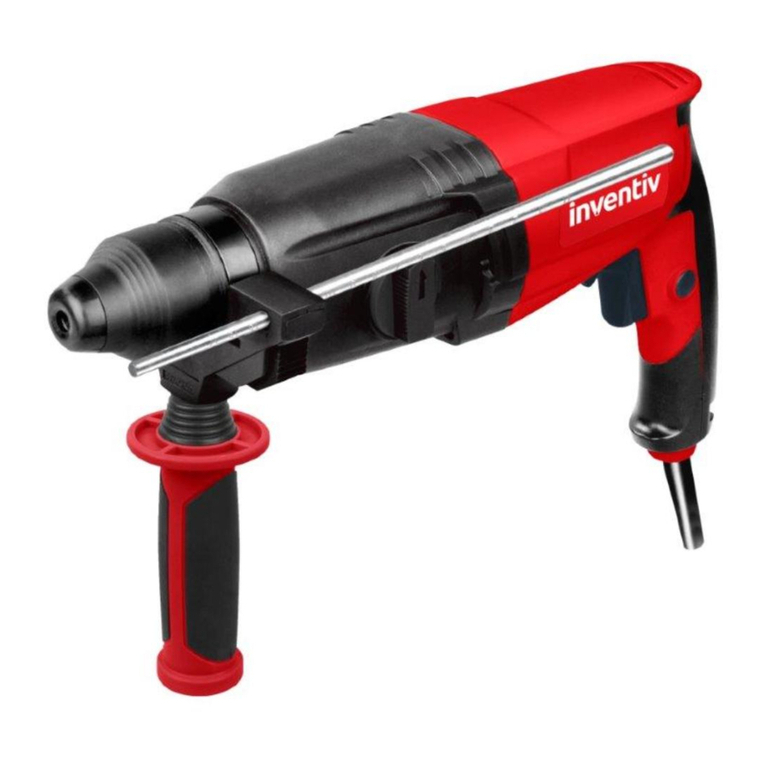Heinner VCRP001 User manual

www.heinner.com VCRP001
Instructions - GB
Instrucțiuni de utilizare - RO
Anleitung - D
Eredeti használati utasítás - HU
Ръководство за употреба - BG
Instrukcja obsługi - PL

ROTARY HAMMER
Thank you for choosing Heinner!
GENERAL SAFETY RULES
WARNING:
For your personal safety, READ and UNDERSTAND before using. SAVE THESE INSTRUCTIONS FOR
FUTURE REFERENCE.
WARNING:
Read and understand all instructions. Failure to follow all instructions listed below may result in
electric shock, fire and/or serious injury. The term "power tool" in all of the warnings listed
below refers to your mains-operated (corded) power tool or battery-operated (cordless) power
tool.
SAVE THESE INSTRUCTIONS
Work area safety
1. Keep work area clean and well lit. Cluttered benches and dark areas invite accidents.
2. Do not operate power tools in explosive atmospheres, such as in the presence of
flammable liquids, gases, or dust. Power tools create sparks which may ignite the dust or
fumes.
3. Keep children and bystanders away while operating a power tool. Distractions can cause
you to lose control.
Electrical safety
4. Power tool plugs must match the outlet. Never modify the plug in any way. Do not use
any adapter plugs with earthed (grounded) power tools. Unmodified plugs and matching
outlets will reduce risk of electric shock.
5. Avoid body contact with earthed or grounded surfaces such as pipes, radiators, ranges and
refrigerators. There is an increased risk of electric shock if your body is earthed or grounded.
6. Do not expose power tools to rain or wet conditions. Water entering a power tool will
increase the risk of electric shock.
7. Do not abuse the cord. Never use the cord for carrying, pulling or unplugging the power
tool. Keep cord away from heat, oil, sharp edges or moving parts. Damaged or entangled
cords increase the risk of electric shock.
8. When operating a power tool outdoors, use an extension cord suitable for outdoor use.
Use of a cord suitable for outdoor use reduces the risk of electric shock.
Personal safety
9. Stay alert, watch what you are doing and use common sense when operating a power tool.
Do not use a power tool while you are tired or under the influence of drugs, alcohol or
medication. A moment of inattention while operating power tools may result in serious
personal injury.
10. Use safety equipment. Always wear eye protection. Safety equipment such as dust mask,
non-skid safety shoes, hard hat, or hearing protection used for appropriate conditions will
reduce personal injuries.
11. Avoid accidental starting. Ensure the switch is in the off-position before plugging in.
Carrying power tools with your finger on the switch or plugging in power tools that have the
switch on invites accidents.
12. Remove any adjusting key or wrench before turning the power tool on. A wrench or a key

ROTARY HAMMER
left attached to a rotating part of the power tool may result in personal injury.
13. Do not overreach. Keep proper footing and balance at all times. This enables better control
of the power tool in unexpected situations.
14. Dress properly. Do not wear loose clothing or jewellery. Keep your hair, clothing and
gloves away from moving parts. Loose clothes, jewellery or long hair can be caught in
moving parts.
15. If devices are provided for the connection of dust extraction and collection facilities,
ensure these are connected and properly used. Use of these devices can reduce dust
related hazards.
Power tool use and care
16. Do not force the power tool. Use the correct power tool for your application. The correct
power tool will do the job better and safer at the rate for which it was designed.
17. Do not use the power tool if the switch does not turn it on and off. Any power tool that
cannot be controlled with the switch is dangerous and must be repaired.
18. Disconnect the plug from the power source before making any adjustments, changing
accessories, or storing power tools. Such preventive safety measures reduce the risk of
starting the power tool accidentally.
19. Store idle power tools out of the reach of children and do not allow persons unfamiliar
with the power tool or these instructions to operate the power tool. Power tools are
dangerous in the hands of untrained users.
20. Maintain power tools, check for misalignment or binding of moving parts, breakage of
parts and any other condition that may affect the power tools operation. If damaged, have
the power tool repaired before use. Many accidents are caused by poorly maintained
power tools.
21. Keep cutting tools sharp and clean. Properly maintained cutting tools with sharp cutting
edges are less likely to bind and are easier to control.
22. Use the power tool, accessories and tool bits etc., in accordance with these instructions
and in the manner intended for the particular type of power tool, taking into account the
working conditions and the work to be performed. Use of the power tool for operations
different from intended could result in a hazardous situation.
Service
23. Have your power tool serviced by a qualified repair person using only identical
replacement parts. This will ensure that the safety of the power tool is maintained.
24. Follow instruction for lubricating and changing accessories.
25. Keep handles dry, clean and free from oil and grease.
SPECIFIC SAFETY RULES
DO NOT let comfort or familiarity with product (gained from repeated use) replace strict
adherence to rotary hammer safety rules. If you use this tool unsafely or incorrectly, you can
suffer serious personal injury.
1. Wear ear protectors. Exposure to noise can cause hearing loss.
2. Use auxiliary handles supplied with the tool. Loss of control can cause personal injury.
3. Hold power tools by insulated gripping surfaces when performing an operation where the
cutting tool may contact hidden wiring or its own cord. Contact with a "live" wire will
make exposed metal parts of the tool "live" and shock the operator.

ROTARY HAMMER
4. Wear a hard hat (safety helmet), safety glasses and/or face shield. Ordinary eye or sun
glasses are NOT safety glasses. It is also highly recommended that you wear a dust mask
and thickly padded gloves.
5. Be sure the bit is secured in place before operation.
6. Under normal operation, the tool is designed to produce vibration. The screws can come
loose easily, causing a breakdown or accident. Check tightness of screws carefully before
operation.
7. In cold weather or when the tool has not been used for a long time, let the tool warm up
for a while by operating it under no load. This will loosen up the lubrication. Without
proper warm-up, hammering operation is difficult.
8. Always be sure you have a firm footing. Be sure no one is below when using the tool in
high locations.
9. Hold the tool firmly with both hands.
10. Keep hands away from moving parts.
11. Do not leave the tool running. Operate the tool only when hand-held.
12. Do not point the tool at any one in the area when operating. The bit could fly out and
injure someone seriously.
13. Do not touch the bit or parts close to the bit immediately after operation; they may be
extremely hot and could burn your skin.
14. Some material contains chemicals which may be toxic. Take caution to prevent dust
inhalation and skin contact. Follow material supplier safety data.
SAVE THESE INSTRUCTIONS
WARNING:
MISUSE or failure to follow the safety rules stated in this instruction manual may cause serious
personal injury.

ROTARY HAMMER
FUNCTIONAL DESCRIPTION AND SPECIFICATIONS
WARNING:
Disconnect the plug from the power source before making any assembly, adjustments or
changing accessories. Such preventive safety measures reduce the risk of starting the tool
accidentally.
1
Dust cap
7
Auxiliary handle
2
Locking sleeve
8
Clamp screw
3
Release button
9
Depth gauge
4
Mode selector switch (drill stop)
10
Adjusting dial
5
Mode selector switch (chisel stop)
11
Grease cover
6
On/Off switch
Model VCRP001
TECHNICAL DATA
Power supply
230V~50Hz
Power input
1500W
No load speed
800/min
Impact rate
4000/min
Impact energy per stroke
4.5J
Protection class
II
Tool holder
SDS-plus
Capacities
Concrete
32mm
Steel
13mm
Wood
40mm
Length of cable
2.0m
Overall length
351mm
Net weight
4.3kgs
LpA: (sound pressure level)
dB(A)
LwA: (sound power level)
dB(A)
Aw: (Vibration level)
ah.Cheq = m/s2
ah.HD = m/s2

ROTARY HAMMER
Intended Use
The tool is intended for hammer drilling in concrete, brick and stone as well as for light chiseling
work. It is also suitable for drilling without impact in wood, metal, ceramic and plastic.
WARNING:
MISUSE or failure to follow the safety rules stated in this instruction manual may cause serious
personal injury.
Switching On and Off
WARNING:
•Before plugging in the tool, always check to see that the switch trigger actuates properly
and returns to the “OFF” position when released.
To start the tool, press the On/Off switch 6and keep it depressed.
To switch off the tool, release the On/Off switch 6.
For low temperatures, the tool reaches the full hammer/impact
capacity only after a certain time.
This start-up time can be shortened by striking the drill/chisel
against the floor one time.
Overload Clutch
If the tool insert becomes caught or jammed, the drive to the drill spindle is interrupted. Because
of the forces that occur, always hold the power tool firmly with both hands and provide for a
secure stance.
If the power tool jams, switch the tool off and loosen the tool insert. When switching the tool
on with the drilling tool jammed, high reaction torques can occur!
WARNING:
•As soon as the power tool jams, switch the tool off immediately. This will help prevent
premature wear of the tool.
Changing the Speed/Impact Rate
The rated speed and impact rate can be adjusted just by turning the adjusting dial 10. The dial
is marked MIN (lowest speed) to MAX (full speed).
Refer to the table below for the relationship between the number
settings on the adjusting dial and the rated speed/impact rate.
Fig. 1

ROTARY HAMMER
Number on adjusting dial
No load speed(rpm)
Impact rate (bpm)
5
800
4000
4
640
3200
3
480
2400
2
320
1600
1
160
800
0
0
0
WARNING:
•If the tool is operated continuously at low speeds for a long time, the motor gets
overloaded, resulting in tool malfunction.
•The speed adjusting dial can be turned only as far as 5 and back to 0. do not force it past
5 or 0, or the speed adjusting function may no longer work.
Mode Selector Switch
Operate the mode selector switch only when the tool is at a standstill. This will help prevent
premature wear of the tool.
Hammer drilling
For drilling in concrete, masonry, etc., depress the release button 3 and rotate the mode selector
switch 4 so that the pointer points to the symbol . Rotate the mode selector switch 5so that
it points to the symbol . Use a tungsten-carbide tipped bit.
Chiseling
For chipping, scaling or demolition operations, depress the release button 3and rotate the mode
selector switch 4so that the pointer points to the symbol . Rotate the mode selector switch
5 so that it points to the symbol .Use a bull point, cold chisel, scaling chisel, etc.
WARNING:
•The mode selector switch 4 must always be locked in the “Chiseling” position when
chiseling.
Fig. 2
Fig. 3

ROTARY HAMMER
Drilling
For drilling in wood, metal or plastic materials, depress the release button 3and rotate the mode
selector switch 4so that the pointer points to the symbol . Rotate the mode selector switch
5 so that it points to the symbol . Use a twist drill bit or wood bit.
WARNING:
The following combination cannot output any function.
ASSEMBLY
WARNING:
•Always be sure that the tool is switched off and unplugged before carrying out any work
on the tool.
Auxiliary handle
WARNING:
•Always use the auxiliary handle to ensure operating safety when drilling in concrete,
masonry, etc.
•When the bit begins to break through concrete or if the bit strikes reinforcing rods
embedded in concrete, the tool may react dangerously. Maintain good balance and safe
footing while holding the tool firmly with both hands to prevent dangerous reaction.
The auxiliary handle swings around to either side, allowing easy handling of the tool in any
position. Loosen the auxiliary handle 7by turning it counterclockwise, swing it to the desired
position and then tighten it by turning clockwise.
Fig. 4
Fig. 5

ROTARY HAMMER
Depth gauge (see figure 6)
The depth gauge 9 is convenient for drilling holes of uniform depth. Insert the depth gauge into
the hole in the grip base. Adjust the depth gauge to the desired depth and then tighten the
clamp screw 8 to secure the depth gauge.
Note: The depth gauge cannot be used at the position where the
depth gauge strikes against the tool body.
Bit grease
Coat the bit shank head beforehand with a small amount of bit grease (about 0.5 -1 g; 0.02 -
0.04 oz.). This chuck lubrication assures smooth action and longer service life
Changing the bit
Before any work on the tool itself, pull the mains plug.
With the SDS-plus tool holder, simpler and easier tool changing is possible without additional
aides.
The dust cap 1largely prevents the entry of drilling dust into the tool holder during operation.
When inserting the tool, take care that the dust cap 1is not damaged.
A damaged dust protection cap should be changed immediately. We recommend having this
carried out by an after-sales service.
Inserting the bit (see figure 7)
Clean and lightly grease the shank end of the tool.
Push back the locking sleeve 2 and Insert the bit in a twisting manner into the tool holder until
it locks itself.
After installing, always make sure that the bit is securely held in place by trying to pull it out.
Removing the bit (see figure 8)
Push back the locking sleeve 2all the way and pull the bit out.
Fig. 6
Tighten
Loosen
Fig. 7
Fig. 8

ROTARY HAMMER
Dust cup
Use the dust cup to prevent dust from falling over the tool and on yourself when performing
overhead drilling operations.
Grease feeding
Caution: Prior to grease feeding, always disconnect the plug from the power supply receptacle.
Since a grease chamber is built in this Rotary Hammer, it can be used for approximately 30 days
without supplying lubricating grease, assuming that the hammer is used continuously 2 hours
daily. Feeding grease into the grease tank as described below before using this hammer.
1. Just before no grease is visible in the grease tank window, when the device is held upright
feed grease to warm it up.
2. Before feeding grease, use the wrench to remove the grease cover. Be careful not to lose
the rubber packing attached below the grease cover.
3. Check the grease level weekly, confirming that grease is filled.
4. After feeding grease, securely clamp the grease cover.
OPERATION
Hammer drilling operation
First set the mode selector switch 4and the mode selector switch 5to the position shown in the
figure 3.
Position the bit at the desired location for the hole, then pull the switch trigger. Do not force the
tool. Light pressure gives best results. Keep the tool in position and prevent it from slipping away
from the hole.
Do not apply more pressure when the hole becomes clogged with chips or particles. Instead, run
the tool at an idle, then remove the bit partially from the hole. By repeating this several times,
the hole will be cleaned out and normal drilling may be resumed.
WARNING:
•There is a tremendous and sudden twisting force exerted on the tool/bit at the time of
hole break-through, when the hole becomes clogged with chips and particles, or when
striking reinforcing rods embedded in the concrete. Always use the auxiliary handle and
firmly hold the tool by both auxiliary handle and switch handle during operations. Failure
to do so may result in the loss of control of the tool and potentially severe injury.
Dust cup
Fig. 9

ROTARY HAMMER
Chiseling operation
First set the mode selector switch 4 and the mode selector switch 5 to the position shown in the
figure 4.
Hold the tool firmly with both hands. Turn the tool on and apply slight pressure on the tool so
that the tool will not bounce around, uncontrolled. Pressing very hard on the tool will not
increase the efficiency.
Drilling operation
First set the mode selector switch 4and the mode selector switch 5 to the position shown in the
figure 5.
Use the drill chuck assembly, you can drill up to 13 mm (1/2”) diameter in metal and up to 40
mm (1-9/16”) diameter in wood.
WARNING:
•Never use “Hammer drilling” when the drill chuck assembly is installed on the tool. The
drill chuck assembly may be damaged.
•Pressing excessively on the tool will not speed up the drilling. In fact, this excessive
pressure will only serve to damage the tip of your bit, decrease the tool performance and
shorten the service life of the tool.
•There is a tremendous twisting force exerted on the tool/ bit at the
•time of hole breakthrough. Hold the tool firmly and exert care when the bit begins to break
through the workpiece.
•Always secure small workpieces in a vise or similar hold down device.
MAINTENANCE
WARNING:
•Always be sure that the tool is switched off and unplugged before attempting to perform
inspection or maintenance.
•For safe and proper working, always keep the tool and ventilation slots clean.
•The tool may be cleaned most effectively with compressed dry air. Always wear safety
goggles when cleaning tools with compressed air.
•Certain cleaning agents and solvents damage plastic parts. Some of these are: gasoline,
carbon tetrachloride, chlorinated cleaning solvents, ammonia and household detergents
that contain ammonia.
Drill chuck assembly
Fig. 10

ROTARY HAMMER
•The brushes and commutator in your tool have been engineered for many hours of
dependable service. To maintain peak efficiency of the motor, we recommend every two
to six months the brushes be examined.
•A damaged dust cap should be changed immediately. We recommend having this carried
out by an after-sales service.
•Store the tool, operating instructions and where necessary the accessories in the original
packaging. In this way you will always have all the information and parts ready to hand.
Changing the carbon brushes
1. Loosen the two screws using a screwdriver and remove the tail cover.
2. Take out the brush holder and the worn carbon brushes.
3. Insert the new brushes in the brush holder.
4. Reinstall the brush holder and the tail cover.
SERVICE
To maintain product SAFETY and RELIABILITY, repairs, any other maintenance or adjustment
should be performed by Factory Service Centers.
DISPOSAL
The tool, accessories and packaging should be sorted for environmental-friendly recycling.
Only for EC countries:
Do not dispose of power tools into household waste!
According the European Guideline 2002/96/EC for Waste Electrical and Electronic Equipment
and its implementation into national right, power tools that are no longer usable must be
collected separately and disposed of in an environmentally correct manner.
Screw
Tail cover
Brush holder
Fig. 11

ROTARY HAMMER
Mode Selector Switch additional content
Hammer drilling: For drilling in concrete, masonry, etc. Use a tungsten-carbide tipped bit.
Chiseling: For chipping, scaling or demolition operations. Use a bull point, cold chisel, scaling
chisel, etc.
Drilling: For drilling in wood, metal or plastic materials. Use a twist drill bit or wood bit.
No function
Wear ear defender
Hammer drilling
Wear safety goggles
Chiseling
Wear a dust mask
Drilling
Double insulation
Recycling
EC-Declaration of conformity
SDS-plus chuck
Max. drilling capacity in concrete

ROTARY HAMMER
RECYCLING
Electrical and electronic equipment waste (WEEE) might contain dangerous materials which
can have a negative impact on the environment and human health if not collected separately.
This item is in conformity with the European Directive EU WEEE (2012/19/EU) and is marked
with an electronic and electrical waste logo graphically represented in the image below.
This icon shows that WEEE should not be collected with household waste but
separately.
We recommend you to consider the following:
- Materials and components used when manufacturing this item are high quality materials
which can be reused and recycled;
- Do not throw away the item with household waste at the end of life;
-Take the item to a collecting point where it will be collected for free;
-Please contact the local authorities for details on the collecting centers.
Conformity with the RoHS Directive: the item you purchased is in conformity with the EU
Directive RoHS (2011/65/UE). It does not contain materials listed as harmful or prohibited in
the Directive.
Thank you for helping us protect the environment and our health!
Manufactured for
Network One Distribution
Marcel Iancu St., no. 3-5, Bucharest, 020757
2018
Table of contents
Other Heinner Rotary Hammer manuals

